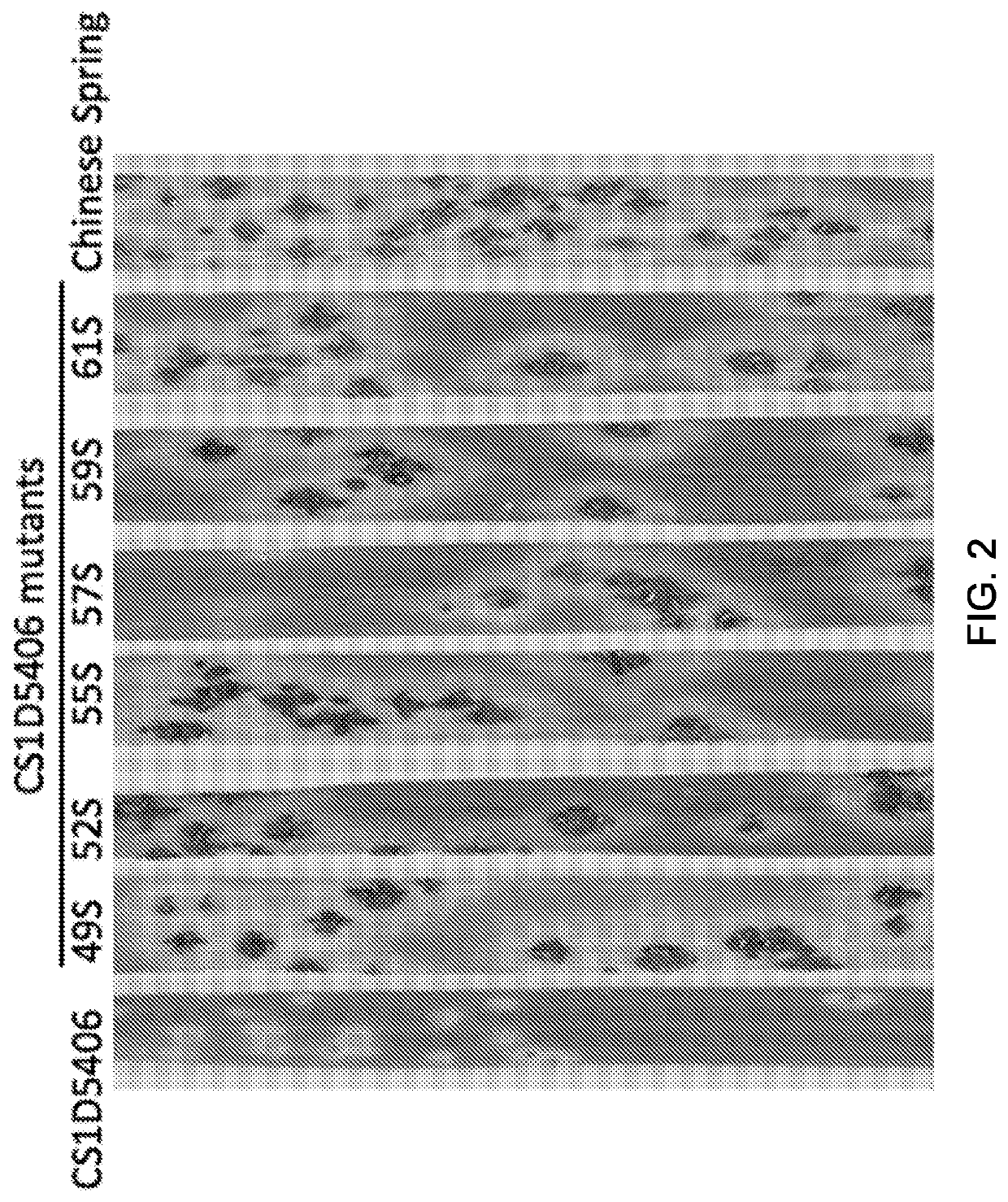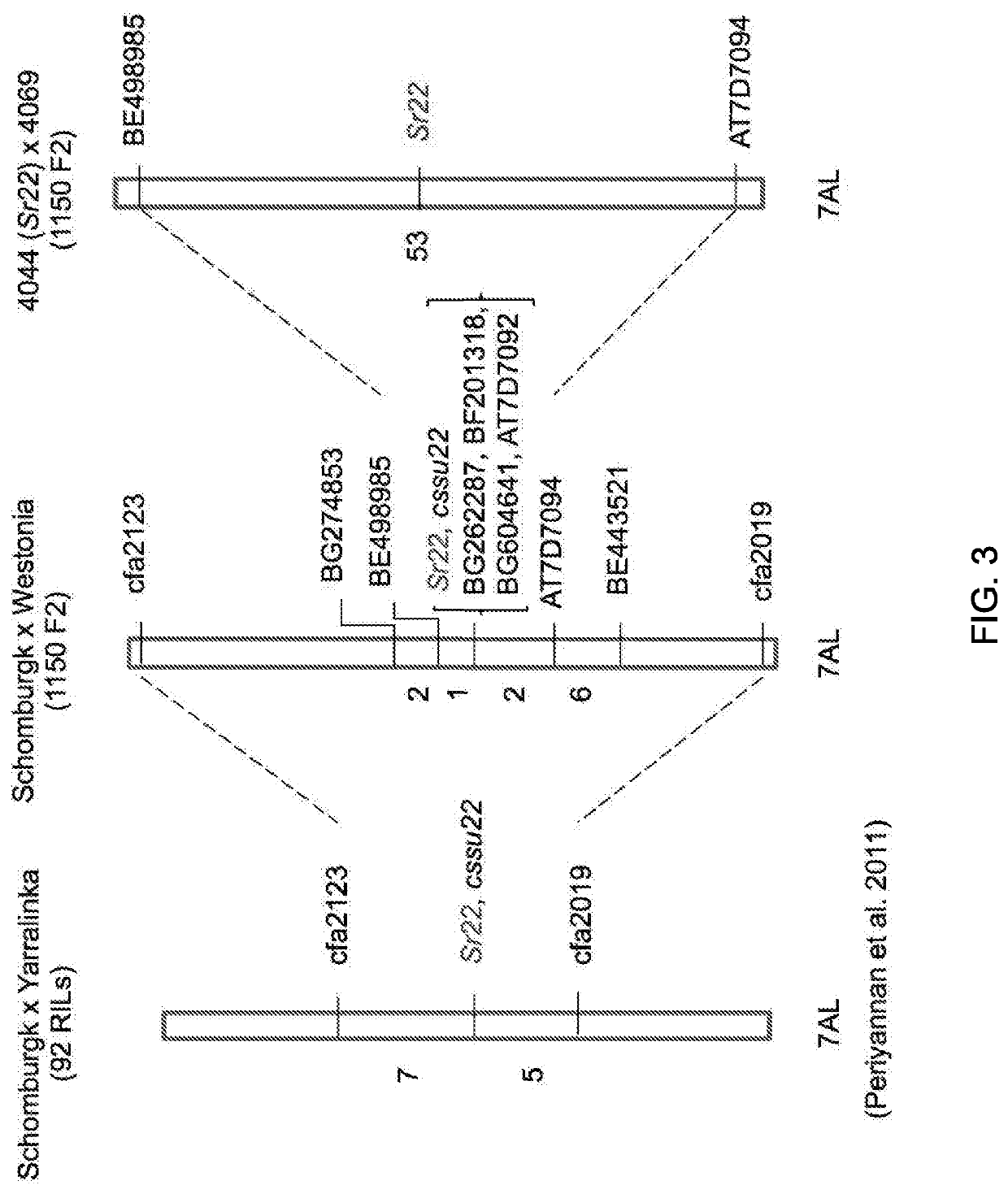Wheat stem rust resistance genes and methods of use
a technology of rust resistance and wheat stem, which is applied in the field of gene isolation and plant improvement, can solve the problems of significant yield loss in world-wide wheat production, and high cost of pesticides
- Summary
- Abstract
- Description
- Claims
- Application Information
AI Technical Summary
Benefits of technology
Problems solved by technology
Method used
Image
Examples
example 1
apping of Sr22 and Sr45
[0222]Sr22 was introgressed into wheat chromosome 7A from the diploid A-genome relative T. boeoticum (Gerechter-Amitai et al. (1971) Euphytica 20:281-285; The (1973) Nature-New Biol. 241:256). In the cultivar Schomburgk Sr22 confers resistance to commercially important races of stem rust worldwide including the Ug99 race group, and is one of the few resistance genes effective against Yemeni and Ethiopian isolates (FIG. 1; Table 1). However, deployment of Sr22 has been limited due to poor agronomic performance conferred by linked gene alleles (The et al. (1988) Proceedings of 7th International Wheat Genetics Symposium, Miller and Koebner eds., Bath Press, Bath, UK, pp. 901-909), and our attempts to clone Sr22 in wheat with a standard map-based approach were thwarted due to suppressed recombination (FIG. 3).
[0223]We generated a mapping population by crossing Schomburgk, the hexaploid wheat line carrying Sr22 from Triticum boeoticum accession G-21 (Paull et al. (...
example 2
n-Seq+EMS to Clone Resistance Genes from Large Genomes
[0227]A three-step method was employed for the rapid cloning of an R gene based on (i) chemical mutagenesis and screening for susceptible mutants, (ii) exome capture and next-generation sequencing, followed by (iii) sequence comparison of wildtype and mutants. As described below, this three-step method was used to clone the broad-spectrum stem rust resistance genes Sr22 and Sr45 from the 17 Gb hexaploid bread wheat genome.
[0228]The majority of plant R genes belong to the structural class of genes that encode nucleotide-binding and leucine-rich repeat (NB-LRR) domains (Dangl et al. (2013) Science 341:746-751). A typical plant genome contains hundreds of NB-LRR homologues (the “NB-LRRome”), most of which reside in complex clusters (Hulbert et al. (2011) Annu. Rev. Phytopathol. 39:285-312). R gene enrichment sequencing (RenSeq) of this smaller, specific region of a plant genome is possible by capturing fragments from an Illumina lib...
example 3
n of an EMS Mutant Population
[0229]We performed EMS mutagenesis as described by Periyannan et al. (Periyannan et al. (2013) Science 341:786-788) on seeds of Schomburgk (carrying Sr22) and CS1D5406 (carrying Sr45). In the kill-curve analysis, 0.3% EMS was identified as the optimum dose to cause 50% mortality and reduced growth. We then treated 2,000 and 3,000 seeds of CS1D5406 and Schomburgk, respectively with this concentration and advanced the plants to the M2 generation. We harvested 680 and 1300 single heads (M2 families from EMS treated CS1D5406 and Schomburgk) and screened these for response to Australian stem rust race 40-1,2,3,4,5,6,7 (PBI culture number 383). From the rust screening of different M2 families, we identified six susceptible mutants (1S, 2S, 3S1, 5S1, 6S, and 7S1) for Sr22 (FIG. 1) and 6 mutants (49S1, 52S1, 55S1, 57S1, 59S1 and 61S1) for Sr45 that were re-confirmed in the M3 generation (FIG. 2).
PUM
| Property | Measurement | Unit |
|---|---|---|
| temperature | aaaaa | aaaaa |
| temperature | aaaaa | aaaaa |
| pH | aaaaa | aaaaa |
Abstract
Description
Claims
Application Information
 Login to View More
Login to View More - R&D
- Intellectual Property
- Life Sciences
- Materials
- Tech Scout
- Unparalleled Data Quality
- Higher Quality Content
- 60% Fewer Hallucinations
Browse by: Latest US Patents, China's latest patents, Technical Efficacy Thesaurus, Application Domain, Technology Topic, Popular Technical Reports.
© 2025 PatSnap. All rights reserved.Legal|Privacy policy|Modern Slavery Act Transparency Statement|Sitemap|About US| Contact US: help@patsnap.com



